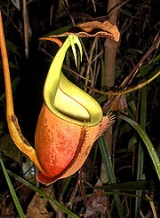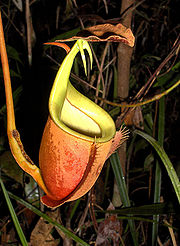
Camponotus schmitzi
Encyclopedia

Carpenter ant
Carpenter ants are large ants indigenous to many parts of the world. They prefer dead, damp wood in which to build nests. They do not eat it, however, unlike termites. Sometimes carpenter ants will hollow out sections of trees. The most likely species to be infesting a house in the United States...
native to northwestern Borneo
Borneo
Borneo is the third largest island in the world and is located north of Java Island, Indonesia, at the geographic centre of Maritime Southeast Asia....
.
The ant makes its nest in the hollow tendrils of the pitcher plant
Pitcher plant
Pitcher plants are carnivorous plants whose prey-trapping mechanism features a deep cavity filled with liquid known as a pitfall trap. It has been widely assumed that the various sorts of pitfall trap evolved from rolled leaves, with selection pressure favouring more deeply cupped leaves over...
Nepenthes bicalcarata
Nepenthes bicalcarata
Nepenthes bicalcarata , also known as the Fanged Pitcher-Plant, is a tropical pitcher plant endemic to northwestern Borneo.-Botanical history:...
.
This unique animal-plant interaction was noted by Frederick William Burbidge
Frederick William Burbidge
Frederick William Thomas Burbidge was a British explorer who collected many rare tropical plants for the famous Veitch Nurseries. Burbidge's first job was as a gardener at Kew Gardens...
as early as 1880. In 1904, Odoardo Beccari
Odoardo Beccari
Odoardo Beccari was an Italian naturalist perhaps best known for discovering the titan arum, the plant with the largest unbranched inflorescence in the world, in Sumatra in 1878...
suggested that the ants feed on insects found on and around the plant, but may fall prey to it themselves. In 1990, B. Hölldobler and E.O. Wilson proposed that N. bicalcarata and C. schmitzi form a mutually beneficial association. At the time, however, no experimental data existed to support such a hypothesis. A series of observations and experiments carried out in Brunei
Brunei
Brunei , officially the State of Brunei Darussalam or the Nation of Brunei, the Abode of Peace , is a sovereign state located on the north coast of the island of Borneo, in Southeast Asia...
by Charles Clarke
Charles Clarke (botanist)
Dr. Charles M. Clarke is a botanist and taxonomist specialising in the carnivorous plant genus Nepenthes. Clarke has an honours degree in Botany from Monash University in Melbourne, and a Ph.D. in Ecosystem Management at the University of New England, in Armidale, New South Wales.Clarke first...
in 1992 and 1998, and by Clarke and Kitching in 1993 and 1995, strongly support the mutualism theory.
The ants feed by descending into the pitcher fluid and retrieving arthropod
Arthropod
An arthropod is an invertebrate animal having an exoskeleton , a segmented body, and jointed appendages. Arthropods are members of the phylum Arthropoda , and include the insects, arachnids, crustaceans, and others...
s caught by the plant. The ants seem to ignore smaller insects and only target larger prey items. Hauling food from the pitcher fluid to the peristome, a distance of no more than 5 cm, may take up to 12 hours. In this way the contents of N. bicalcarata pitchers is controlled such that organic matter does not accumulate to the point of putrefaction
Putrefaction
Putrefaction is one of seven stages in the decomposition of the body of a dead animal. It can be viewed, in broad terms, as the decomposition of proteins, in a process that results in the eventual breakdown of cohesion between tissues and the liquefaction of most organs.-Description:In terms of...
, which can lead to the demise of pitcher infauna
Nepenthes infauna
Nepenthes infauna are the organisms that inhabit the pitchers of Nepenthes plants. These include fly and midge larvae, spiders, mites, ants, and even a species of crab, Geosesarma malayanum. The most common and conspicuous predators found in pitchers are mosquito larvae, which consume large...
(which also appear to benefit the plant) and sometimes the pitcher itself.
The ants seem to favour upper pitchers and rarely colonise lower pitchers. This is likely because terrestrial traps are periodically submerged in water during heavy rains. Flooding of the ants' nest chamber could result in the death of the developing eggs, larva
Larva
A larva is a distinct juvenile form many animals undergo before metamorphosis into adults. Animals with indirect development such as insects, amphibians, or cnidarians typically have a larval phase of their life cycle...
e, and pupa
Pupa
A pupa is the life stage of some insects undergoing transformation. The pupal stage is found only in holometabolous insects, those that undergo a complete metamorphosis, going through four life stages; embryo, larva, pupa and imago...
e.
C. schmitzi nests solely in the tendrils of N. bicalcarata and rarely ventures onto other plants. The species is completely dependent on N. bicalcarata for food and domicile. N. bicalcarata, on the other hand, is able to survive and reproduce without the presence of the ants; it is a facultative mutualist. This being the case, there appear to be few mature plants over 2 metres in height not colonised by C. schmitzi.
John Thompson suggests that N. bicalcarata may be the only plant species that obtains nutrients through both insect capture and ant-hosting habits.

